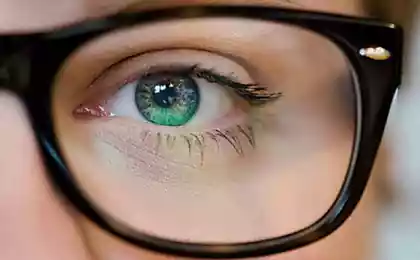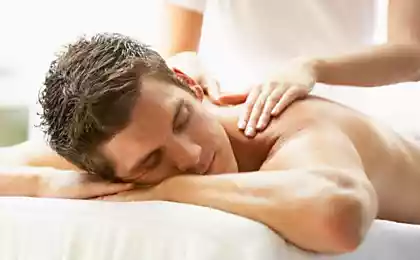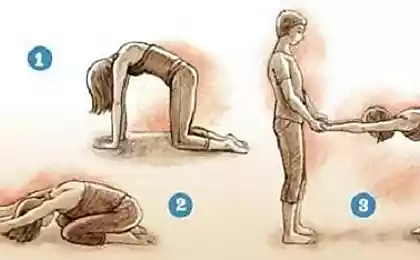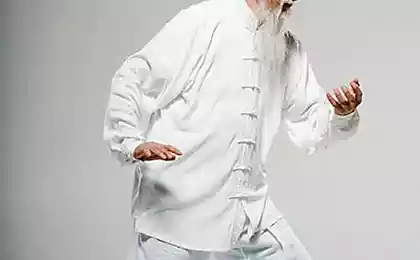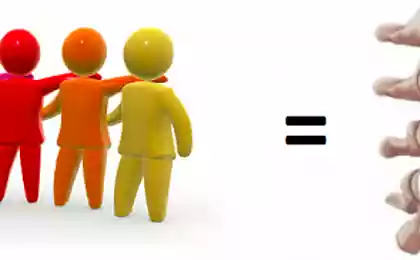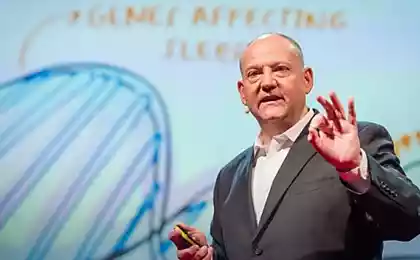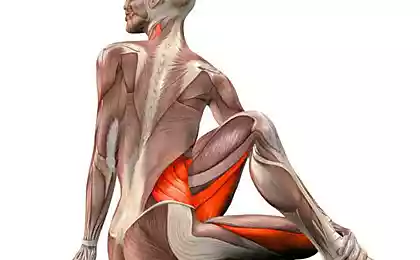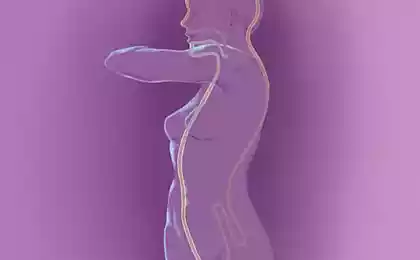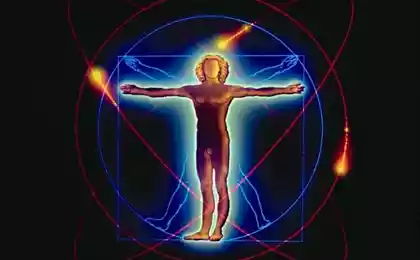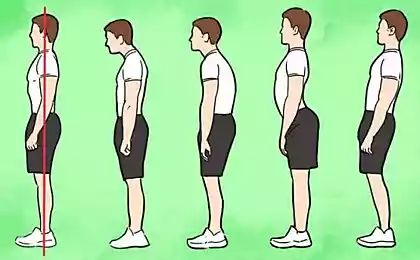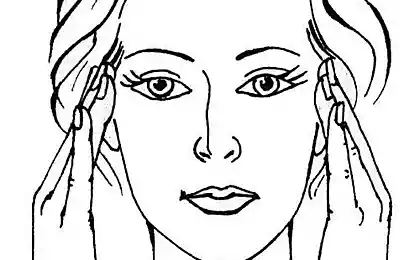522
Exercise "EIGHT" will put the displaced vertebrae into place
STANDING
A great influence on the posture having the normal way of standing.
Most people (especially teenagers and young) always stand on one leg while the other leg is slightly bent in the knee joint and is actually released from the load. After 2-4 minutes standing "changes legs" – transferring weight of body from one to another. Usually the person gets used longer term to stand on one leg. For example, on the right – 4 minutes, and on the left side for 1-2 minutes.

What happens because of this posture? Above all, there is the asymmetry of the relief of the neck, when one shoulder goes down, the level of the shoulder blades and the ridges of the iliac bones shifted. Muscles of half the body from the bent legs relax, and the muscles of the other half overextend. Greatly disturbed posture, curved spine, stretches the ligaments of the vertebral (especially lumbar spine). The consequence of this isthe change of the boundary points of the vertebral bodies – is developing osteochondrosis of the spine with severe pain (sciatica, lumbago). In some cases even protrude or fall out of the intervertebral discs leads to sharp pain. Therefore, it is important to learn how to stand.
SITTING
It is necessary to sit with a straight back. The buttocks must be on the rear of the rigid and literal seat. The waist should fit snugly to the back of the chair, the form of which must correspond to the physiological curves of the spine. The stomach needs to be picked up and not relaxed, the shoulders straight and relaxed normally, the head in a natural position.
The chair seat should be flat and shorter than thighs. This is necessary in order that the edge of the chair did not peretasoval veins and arteries under the knee and does not interfere with the normal circulation in the legs.
Height of chair from seat to floor should be the same as the distance from the hips to the floor. This is necessary in order to feet stood on the floor rather than hung in the air like little kids.
To sit and stand from a chair (chair) should smoothly and gently. Equally harmful as rapid lowering and getting up from a chair. This creates an increased load on the intervertebral discs, which over time can cause damage.
During landing on a chair the head should be facing forward and up, neck relaxed, spine straight. The weight of the body falls only on the feet, which should gently lower the body in the chair.
When you rise from a chair, then lean forward, keeping your back straight. The head should be in a natural position. It is not recommended to help himself with his hands when landing and standing up from his chair. Should work legs, a straight back to lean forward.
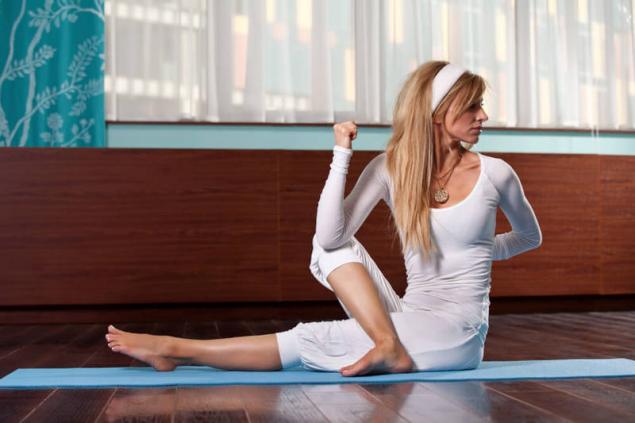
It is not recommended to sit a long time in a too-soft armchair. It back muscles to relax and the entire burden falls on the intervertebral discs. They are flattened under pressure, and if it lasts long enough and regularly back starts to ache.
When sitting, do not put the foot on the leg! At the level of energy this leads to overlapping of the channels located in the pelvis. Over time, this bad habit can cause pain in the lower part of the spine and even lead to diseases of the genital organs.
Of course, you'll need some time to master the correct seat. At first it will seem awkward, but with time you will feel complete relaxation and rest from the seat, as the body will be in a natural position.
LYING
As for a night's rest in bed, the spine it has some features.
During sleep, the body muscles relax, including the tonic muscles of the spine. Now the spine is not supported by them, taking the form of the surface on which it lies. If the bed is soft, the body is pressed to it and the spine can SAG. Conversely, the relatively hard surface of the bed causes the spine to bend in the opposite direction.
There are many tips on how to sleep better: on back, on stomach, on the side. Each of you will select the position that most suits you.
Therefore, for a complete relaxation of the spine, the bed should be smooth, but not hard. It gives the chance to the bones of the shoulders and pelvis to create your own natural depression. The spine relaxes on a bed and becomes flat and elongated.
To make to sleep in the right bed, can be put under the mattress sheet of thick plywood.
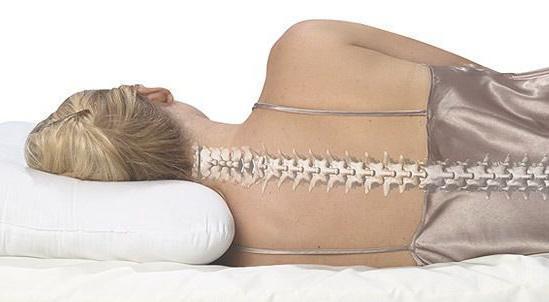
Pillow should be small and soft enough. This pillow helps to keep the cervical and thoracic spine in a straight position that allows the torso muscles to fully relax during sleep.
By the way, sleeping without pillow helps to ensure that the person's facial wrinkles are formed much slower.
During sleep, never let any part of the body was squeezed or pressed on the other. This prevents normal circulation of blood in that part and causes numbness.
In order to fall asleep faster and relax better, you should in the cold season to warm the body, the face area, especially the feet. Then sleep and relaxation comes quickly, and the person is fully at rest.

EXERCISE "EIGHT"
Very often people in the awakening feel discomfort in the spine. This is because during sleep, the tonic muscles that support the vertebrae in proper position, relax and the vertebrae are shifted slightly relative to each other. This is what leads to pain. This is often the case in elderly and senile age.
To put offset after sleep vertebrae in place, you can do right in bed with a simple exercise. Lying in bed, do 20-60 times a horizontal "eight" – like symbol of "infinity".
This exercise is: lying on your back, you try to slowly move your pelvis as if you are drawing an eight.
As a result, the spine will be bent slightly and stretch – enough to put offset after sleeping the vertebrae in place and to avoid trouble.
Men need to do the exercise clockwise (to the right), counterclockwise (to the left).
The pelvis not tear, the pace is slow, the trunk relaxed. Breathing without delay, through the nose. Movement in the pelvis a beneficial effect on the stomach, improving digestive ability.
Also interesting: bad back: stretch or "loading"
Psychosomatics: the Back is the place where we put all that we have no desire to watch
Having mastered this exercise, you can include the complex and a "vertical eight". The main thing – to take the time to listen carefully to your body as movement occurs in the spine.published
The materials are for informational purposes. Remember, self-life-threatening, for advice regarding the use of any medicines and methods of treatment, contact your doctor.
Source: vk.com/wall-23903469?offset=4500&w=wall-23903469_701%2Fall
A great influence on the posture having the normal way of standing.
Most people (especially teenagers and young) always stand on one leg while the other leg is slightly bent in the knee joint and is actually released from the load. After 2-4 minutes standing "changes legs" – transferring weight of body from one to another. Usually the person gets used longer term to stand on one leg. For example, on the right – 4 minutes, and on the left side for 1-2 minutes.

What happens because of this posture? Above all, there is the asymmetry of the relief of the neck, when one shoulder goes down, the level of the shoulder blades and the ridges of the iliac bones shifted. Muscles of half the body from the bent legs relax, and the muscles of the other half overextend. Greatly disturbed posture, curved spine, stretches the ligaments of the vertebral (especially lumbar spine). The consequence of this isthe change of the boundary points of the vertebral bodies – is developing osteochondrosis of the spine with severe pain (sciatica, lumbago). In some cases even protrude or fall out of the intervertebral discs leads to sharp pain. Therefore, it is important to learn how to stand.
SITTING
It is necessary to sit with a straight back. The buttocks must be on the rear of the rigid and literal seat. The waist should fit snugly to the back of the chair, the form of which must correspond to the physiological curves of the spine. The stomach needs to be picked up and not relaxed, the shoulders straight and relaxed normally, the head in a natural position.
The chair seat should be flat and shorter than thighs. This is necessary in order that the edge of the chair did not peretasoval veins and arteries under the knee and does not interfere with the normal circulation in the legs.
Height of chair from seat to floor should be the same as the distance from the hips to the floor. This is necessary in order to feet stood on the floor rather than hung in the air like little kids.
To sit and stand from a chair (chair) should smoothly and gently. Equally harmful as rapid lowering and getting up from a chair. This creates an increased load on the intervertebral discs, which over time can cause damage.
During landing on a chair the head should be facing forward and up, neck relaxed, spine straight. The weight of the body falls only on the feet, which should gently lower the body in the chair.
When you rise from a chair, then lean forward, keeping your back straight. The head should be in a natural position. It is not recommended to help himself with his hands when landing and standing up from his chair. Should work legs, a straight back to lean forward.

It is not recommended to sit a long time in a too-soft armchair. It back muscles to relax and the entire burden falls on the intervertebral discs. They are flattened under pressure, and if it lasts long enough and regularly back starts to ache.
When sitting, do not put the foot on the leg! At the level of energy this leads to overlapping of the channels located in the pelvis. Over time, this bad habit can cause pain in the lower part of the spine and even lead to diseases of the genital organs.
Of course, you'll need some time to master the correct seat. At first it will seem awkward, but with time you will feel complete relaxation and rest from the seat, as the body will be in a natural position.
LYING
As for a night's rest in bed, the spine it has some features.
During sleep, the body muscles relax, including the tonic muscles of the spine. Now the spine is not supported by them, taking the form of the surface on which it lies. If the bed is soft, the body is pressed to it and the spine can SAG. Conversely, the relatively hard surface of the bed causes the spine to bend in the opposite direction.
There are many tips on how to sleep better: on back, on stomach, on the side. Each of you will select the position that most suits you.
Therefore, for a complete relaxation of the spine, the bed should be smooth, but not hard. It gives the chance to the bones of the shoulders and pelvis to create your own natural depression. The spine relaxes on a bed and becomes flat and elongated.
To make to sleep in the right bed, can be put under the mattress sheet of thick plywood.

Pillow should be small and soft enough. This pillow helps to keep the cervical and thoracic spine in a straight position that allows the torso muscles to fully relax during sleep.
By the way, sleeping without pillow helps to ensure that the person's facial wrinkles are formed much slower.
During sleep, never let any part of the body was squeezed or pressed on the other. This prevents normal circulation of blood in that part and causes numbness.
In order to fall asleep faster and relax better, you should in the cold season to warm the body, the face area, especially the feet. Then sleep and relaxation comes quickly, and the person is fully at rest.

EXERCISE "EIGHT"
Very often people in the awakening feel discomfort in the spine. This is because during sleep, the tonic muscles that support the vertebrae in proper position, relax and the vertebrae are shifted slightly relative to each other. This is what leads to pain. This is often the case in elderly and senile age.
To put offset after sleep vertebrae in place, you can do right in bed with a simple exercise. Lying in bed, do 20-60 times a horizontal "eight" – like symbol of "infinity".
This exercise is: lying on your back, you try to slowly move your pelvis as if you are drawing an eight.
As a result, the spine will be bent slightly and stretch – enough to put offset after sleeping the vertebrae in place and to avoid trouble.
Men need to do the exercise clockwise (to the right), counterclockwise (to the left).
The pelvis not tear, the pace is slow, the trunk relaxed. Breathing without delay, through the nose. Movement in the pelvis a beneficial effect on the stomach, improving digestive ability.
Also interesting: bad back: stretch or "loading"
Psychosomatics: the Back is the place where we put all that we have no desire to watch
Having mastered this exercise, you can include the complex and a "vertical eight". The main thing – to take the time to listen carefully to your body as movement occurs in the spine.published
The materials are for informational purposes. Remember, self-life-threatening, for advice regarding the use of any medicines and methods of treatment, contact your doctor.
Source: vk.com/wall-23903469?offset=4500&w=wall-23903469_701%2Fall
This easy energy exercise will remove the blocks and clamps in the body
My Italian experience. A life without age



